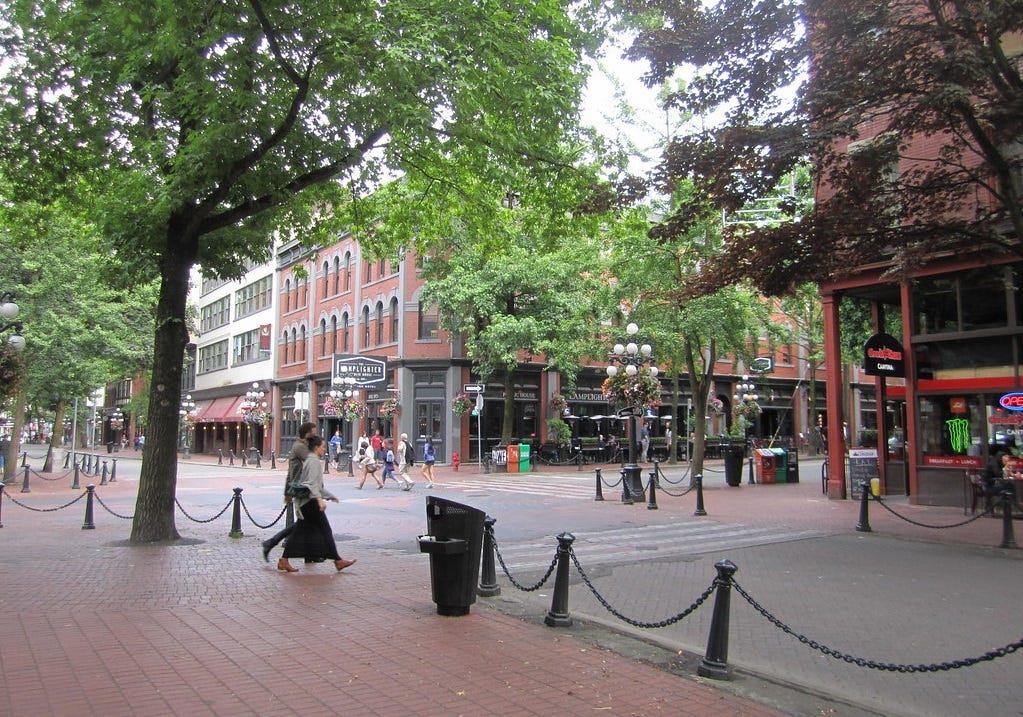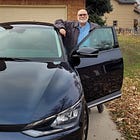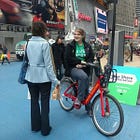Walkable Cities Cut Pollution, Preserve Nature. 'The F*ck Is THIS Sh*t?' — Americans
Nobody's going to make you live in a pod or eat bugs either.

Over the weekend, the Washington Post ran a thoughtful story (gift link) about “15 minute neigborhoods,” the urban design idea that argues that if you have lots of urban areas where people can have easy, walkable access to most of the things they need — groceries, restaurants, services, office space and the like — they’re less likely to need a car, and will create less pollution.
The article links to a recent study from boffins at Sony’s computer lab in Rome (Italy, not Georgia, Michigan, or New York) evaluating how close some 200 metro areas in the USA come to actually having 15 minute neighborhoods, and why, even though those cities are home to about 60 percent of our population, most of their neighborhoods aren’t so walkable. (Cars. The short answer is cars.)
The WaPo story includes a fun little searchable toy where you can see where the most walkable parts of your city are. As I already knew, my old apartment in Boise, fairly near downtown, really was less than a 15-minute walk from lots of stuff, including at least four schools where I sometimes substitute taught, ages ago. My current place, not so much, though plenty of shopping and restaurants are in easy range with an e-bike, at least in a few months when it warms up again. (Lately of course I have to make as many trips as possible with my newly-leased EV, yes I do. BRB need a donut. To eat, not to do one on your lawn.)
And actually it was just an English muffin from the kitchen. I’m not that stupid about cars.
Crazy Thought: Make Not Having A Car Easier
Walkable neighborhoods are certainly conducive to living without a car at all, and as the Post points out, when they’re designed with easy access to good public transit, they can “generate about half of the auto trips of less-dense suburban areas, according to Reid Ewing, a professor of urban planning at the University of Utah.”
But the point of the WaPo story is that, at least for now, walkable neighborhoods are of limited utility as a broad climate solution, at least in the USA, because they tend not to provide what lots of Americans want from housing: space for kids and all the activities and stuff that tends to come with them. The burbs are cheaper, even if they cost society a lot in the long run by causing sprawl, which brings with it not only reliance on personal vehicles, and therefore more pollution, but much more:
Obesity rates are higher, even after controlling for people’s age, race, education and income. So are traffic fatalities and emergency response times. On a per person basis, sprawl is more expensive, with its extensive roads, power lines and sewer systems.
And then of course there’s all that land being converted from either nature or what had been agricultural use. Here’s the best line of the whole piece: “Many people prefer to live in sprawl because it feels closer to nature. Yet the closer humans live to nature, the more damage they tend to do to it.” You know, like the old joke about how streets in subdivisions are all named for the Whispering Pines, Meadow Views, and Deer Trails they were built over.
Ready for more information about Divided America? Brace yourself:
Pew Research Center recently asked 5,079 American adults whether they would prefer to live in a community where the houses are smaller and closer to each other but schools, stores and restaurants are within walking distance — in other words, a 15-minute neighborhood — or where the houses are larger and farther apart but schools, stores and restaurants are several miles away — in other words, sprawl.
Most people, it turned out, preferred sprawl. The only demographic groups in which majorities were willing to give up the larger house for the walkable neighborhood were the young, highly educated and Democratic-leaning.
In the comments to the story, one person complained that it’s not that Americans prefer sprawl, it’s that they simply prefer “larger homes and room to grow a family,” the price of which is that stuff like stores, jobs, and schools end up being more remote, a trade-off they’re willing to make. Congratulations, you just defined sprawl again. (Clearly it is a communist word.)
And yes, there were all sorts of comments about how Democrats want to force everyone to live the way Democrats want, as if the influence of big moneyed interests — in construction, real estate, the auto and fossil fuel industries, and so on — had no effect at all on how our cities and suburbs have taken shape. Let’s be clear: Nobody is saying walkability will be imposed on everyone, just that it’s an option that makes a hell of a lot of sense, and might even be encouraged as a policy.
The Price Of Convenience. (Whose Convenience?)
Because space in cities is at a premium, at least in neighborhoods where relatively affluent white people want to live, that’s how you end up with small condos near shopping, offices, and bistros costing far more per square foot than they would in the suburbs, where you’d have to drive to the other stuff. Walkable neighborhoods are clearly in demand, at least among people willing to pay the higher prices, so why not create a lot more walkable neighborhoods to meet that demand, and maybe even bring down the costs of housing?
As the WaPo story notes, that’s much easier said than done, given that so many of our cities and suburbs, were designed around cars, with highways “dissecting [sic] areas where walkable neighborhoods might otherwise be built.”
In addition to using the wrong word, the Post elides the very well-documented history of how in many cities, those freeways actually bisected established, walkable neighborhoods mostly populated by Black and Hispanic people, although it does at least note that the the 2021 infrastructure law included funds aimed at reconnecting such neighborhoods where possible, mentioning that “In March, Boston won a $335 million grant to build a park to pass over I-90 so that people in Allston and Brighton will be able to walk to the Charles River.”
There are other solutions as well, such as zoning that encourages a mix of residential and businesses, as well as policies that encourage more density via multi-unit housing instead of single-family homes. We could all learn a lot from California Zoning, on such a winter’s day. As for mass transit, it’s worth keeping in mind that early suburbs were connected to jobs in cities not by freeways, but by streetcars. Bring back the Streetcar Suburb!
Now, the other problem with “simply” building more walkable neighborhoods in cities — which the Post didn’t explore, unfortunately — is that such developments can amount to gentrification, chasing big bucks by driving out existing working-class minority residents. That’s a whole ‘nother conversation that could double the length of this piece, so we’ll come back to it in a standalone follow-up. But here’s a preview: As plenty of people working on housing policy, climate, and sustainability have argued, walkability and sustainability should be goals for everyone, not a luxury reserved for the rich.
Ray Bradbury Saw It Coming (It Was Here Already In 1949)
Finally, I need to mention another comment from the Post story, which insisted that it’s downright “un-American to live and raise children in apartment like houses buried in commercial areas,” and that all this “walkable” nonsense is just a plot driven by developers and the real estate business to enrich themselves while touting “fake environmental benefits.” It was pretty impressive, since most of us fools might think it’s bad for the environment to convert more and more land to housing that requires more cars. Said the letter writer,
Majority of Americans living in detached single family homes at 2/5th to an acre lot is American way of life. That's where we live, raise our children and live in privacy and peace.
This reminded me of something I read a million years ago in high school, Ray Bradbury’s 1951 science fiction story “The Pedestrian,” a tale about a guy in far-off 2053 who likes to take long walks in the evening, in a city where everyone stays ensconced in their homes, curtains drawn, TVs blaring. His being out in the evening draws the attention of a robot police car, and [spoiler warning] he’s arrested and taken off to be studied at the “Psychiatric Center for Research on Regressive Tendencies.”
Bradbury said the story was inspired by an incident in Los Angeles in 1949, when he and a friend were stopped by a cop while they walked on Wilshire Boulevard. The cop demanded to know what they were doing, and didn’t appreciate Bradbury’s smartass reply, “Well, we're putting one foot in front of the other.” Happily, no institution for him! The event clearly made an impression on Bradbury, since he later included a version of it in Fahrenheit 451.
I was also reminded of that long-ago Victoria Jackson rant about how bike lanes are part of a vast UN plot to first take away our cars, and then our freedom, a conspiracy theory that has since become the belief that Democrats want “15-minute cities” so they can lock up everyone in an assigned urban zone from which no one can ever leave. You know us libs, always doing repression.
But here’s why people get so worked about discussions of land use and urban design: They literally hit us where we live, and by god you’re not going to make us live with less crap, OK?
[WaPo (gift link) / “The Pedestrian” wiki entry / Governing / Strong Towns]
Yr Wonkette is funded entirely by reader donations. If you can, please become a paid subscriber, or if you’d like to make a one-time donation to help us get out and walk a bit, here is your button.







Since leasing an EV last week, I've written 2 pieces about how we can make it possible for people to get by without cars, with another in the planning stages.
My Catholic upbringing no doubt features in this somehow.
I used to get my glasses from a Gastown, Vancouver, B.C. optometrist. Loved that place. Best glasses ever.
Separately... This is another example of Dok's writing that demonstrates his unique appeal. I love the Ray Bradbury vignette, the willingness to engage with aspects of a story that can't be reduced to single, simple points, and the gentle hope peeking through the hedge of rational expectations.
Love ya, Dok.